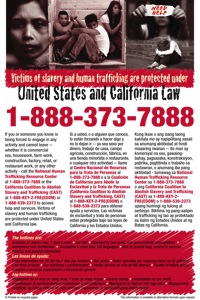
Since 2010, when New Jersey was chosen to host Super Bowl XLVIII, business leaders have been building the infrastructure for a successful event. Rooms have been booked. Travel plans have been made. Pipelines have been built to guarantee enough product.
For T-shirts, that’s great. For liquor, it’s at least legal. For victims of human trafficking, it’s the beginning of a well-orchestrated tragedy.
According to many experts, the Super Bowl is the largest human trafficking “event” of the year. 10,000 sex workers were reportedly needed to meet Miami’s demand in 2010, many of whom were forced to continue in what has become an all too common form of modern day slavery.
Sex trafficking is only part of the story. Many of the 600,000-800,000 annual victims are forced to work in service industries, agriculture and sweatshops. If they are paid at all, it is insufficient to break the cycle of debt that binds them to their “pimps.”
The majority of victims are women. Many are under 18. Some are imported, while others are found domestically, either through kidnapping or becoming trapped after what was meant to be a one-time experience. As laws and enforcement have tightened on drugs, many traffickers have turned to humans as a safer commodity. It helps that their victims are often seen as criminals by prostitution and immigration laws.
While events like the Super Bowl are magnets for trafficking, the bright lights can also illuminate the problem in the darkness. The New Jersey attorney general has established a task force to deter trafficking at and after the Super Bowl. The New Jersey Coalition Against Human Trafficking has tried to stay a step ahead this year, educating the public and trying to reach current and potential victims where they are most likely to be found: where alcohol is served, sexually oriented businesses, places of travel and emergency rooms to name a few.
As a coastal state with international trade, that outreach should be happening here in California. It is in fact required by SB1193, which defined the information, location and languages for such postings in California. Unfortunately, effective implementation has been difficult due to the somewhat dizzying array of resources and enforcement needed.
We can be proud that San Diego has stepped up its game. In a press conference to highlight January as Human Trafficking Month, Interim Mayor Gloria, members of the San Diego Human Relations Commission, and representatives of law enforcement sparked an initiative to remind businesses of their duties and get them the resources to comply. A large part of that effort involves posters to educate trafficking victims about their rights and where to get help, and they should be going up at bars, bus stations and massage parlors near you.
Knowing what happens in the shadows takes some of the shine off the Super Bowl. While the Chargers aren’t playing in the big game, San Diegans can enjoy it a little more knowing that America’s Finest City is working to get trafficking victims out of the darkness. As individuals, we can do our part to stop trafficking in two ways. When it comes to suspicious circumstances, when you see something, say something. When it comes to educational posters, if you don’t see something, say something.
Joel Trambley serves as vice chair of the City of San Diego Human Relations Commission.











